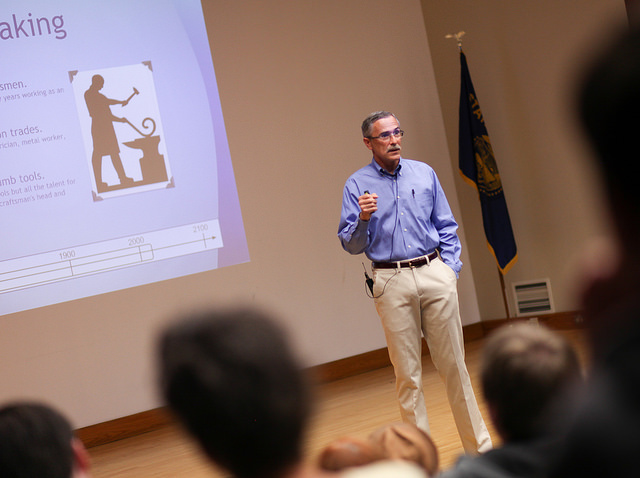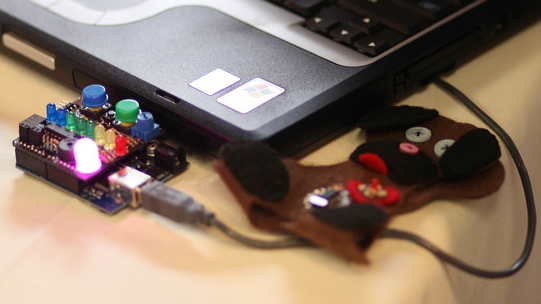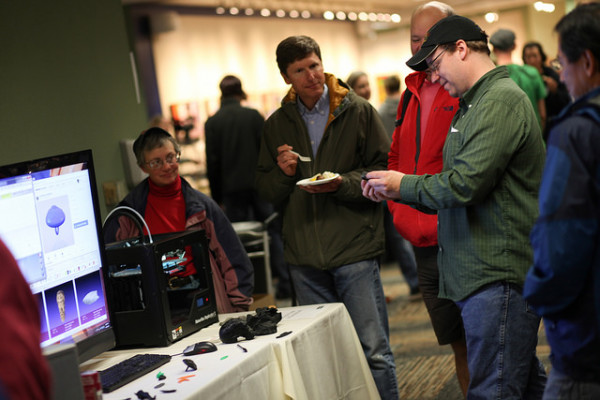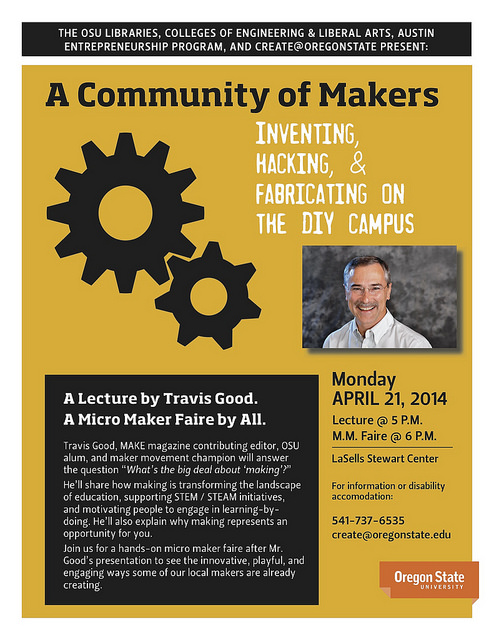
Often when maker communities become aware of one another they begin to collaborate. That’s a concept I’ve seen play out many time, most recently in San Diego after our Mini Maker Faire. Harnessing this insight and being deliberate with its development can lead to great things. This idea has led to the Making a Maker City symposium at MakerCon and Making a Maker Campus which debuted this past week at Oregon State University.
The kickoff at OSU was my speech entitled “What’s the big deal about Making?”
My talk argued that OSU should capitalize on the Maker Movement. Making provides an opportunity to develop tacit learning skills, teaches collaboration and fosters a healthy creative community. Students graduating from such a university will be more employable and will have the ability to remain valuable employees. However, my speech was just the start of a process.
The people behind my visit are concerned with building maker collaborations across the university. Unlike most departments, the Valley Library serves the entire campus while Create@OregonState is chartered with building partnerships between the colleges of Engineering and Liberal Arts. My job was to help them, to catalyze maker collaboration across OSU.
My speech served our first goal of drawing local makers together to one place. Next we needed an excuse for makers to get to know one another and what better than the tried-and-true show-and-tell? We needed maker groups to stage a “micro maker faire” immediately after my speech, immediately outside my auditorium. Finding them and engaging them would be the first test of our hypothesis that maker groups abound.

Remarkable. My partners managed to pull together a wonderfully diverse group of 14 exhibitors, most of whom were unaware of one another and most of whom were unknown to the audience. What they exhibited was fantastic and caught everyones’ attention. To appreciate the quality and variety, here are a few examples of who exhibited:
- Austin Entrepreneurship Program – student start-ups in a full maker space
- OSU Craft Center – from looms, to kilns, to screen printing stations
- Valley Library – central library facility for all OSU with 3D printer
- Collaboratory – product prototyping aligned with and funded by industry
- Corvallis Art Center – dedicated to integrating the arts into community life
- Chick Tech – engaging girls and women with technology
- OSU Robotics Club – competing with robots on land, in sea and sky
- Pacific Slope Archaeology Lab – scanning, sharing, printing, studying ancients
- Benton County Public Library – maker programs for teens, kids, and adults
- Music and Technology Lab – digitally hacking instruments for new sound
These were all existing maker groups on and around campus. They may not have self-identified as makers at first but they knew they belonged and, having seen others’ work, they knew they were part of a larger community. The discovery of other makers and becoming familiar with them and their work are the critical first steps in building a Maker Campus. The next step is fostering collaboration.
Discovery. Familiarity. Collaboration.

The following day was about advancing our agenda as we made our rounds to discuss collaborations, maker spaces and maker events. We met with a diverse cross section of OSU including representatives from colleges of Engineering, Design, Business, Music and Education. Various other communities were also involved and included a public library, an incubator, makerspaces, several local businesses, a gallery, and even someone from Hewlett-Packard which has a sizable operation in Corvallis. It was impressive what my hosts were able to schedule and to learn that there was so much interest.
Over the course of the day we visited existing maker spaces. We held meetings with various faculty and administration about collaborations between and among departments. We discussed prospects for future maker spaces in facilities being redesigned and in new buildings. We coalesced around the idea of inserting more making into a signature event such as their much-vaunted Da Vincci Days. Across the board, collaboration, maker spaces and a maker event were of interest.
In the end, my brief visit could only serve to catalyze. The hard work is for those at OSU who are committed to build maker collaboration. Where this goes is to be seen but I’m excited at the prospect and thank them for the opportunity to have helped.
What I’m finding is that in any large diverse community there are pockets of making. Causing maker groups to become aware of others, creating opportunities where groups can become familiar and comfortable with one another, and catalyzing collaborations on projects of shared interest is the formula for stitching together a larger maker community. Regardless of whether it’s a university, a large company, a city or another large diverse community this roadmap helps reveal and develop its maker character.
Discovery. Familiarity. Collaboration.
This process can work for you too.

2 replies on “Making a Maker Campus”
Hello Travis,
I just finished reading your article in Make Magazine titled Making a Maker Campus. I am trying to bring a Maker Campus here to Denver via TechShop. I am in the concept stage of planning including gathering names of potential investors, educators, and members. I plan on advocating for a facility here in Denver by the end of May.
If you have any advice/input that could be of any guidance I would so appreciate it.
Thanks much,
Eric Wagner
If it’s via TechShop then just lean back because with enough funding their model is self replicating. However, if you’re going it alone then there’s much to learn, assess and plan for. I’d recommend you look at Gui Cavalcanti’s article “Making Makerspaces, Creating a Business Model” here: http://makezine.com/2013/06/04/making-makerspaces-creating-a-business-model/ and his documents for “Make a Makerspace” which can be found in his Dropbox here: https://www.dropbox.com/sh/xn01t8hc8245e5o/SDFKaVqgtY
After have a good feel for what you want to do then we could chat.
There are so many variations and it’s such a big undertaking.
My first advice would be to first find/build your community.